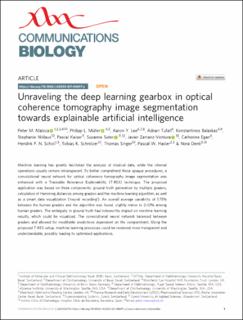Please use this identifier to cite or link to this item:
https://doi.org/10.21256/zhaw-21902Full metadata record
| DC Field | Value | Language |
|---|---|---|
| dc.contributor.author | Maloca, Peter M. | - |
| dc.contributor.author | Müller, Philipp L. | - |
| dc.contributor.author | Lee, Aaron Y. | - |
| dc.contributor.author | Tufail, Adnan | - |
| dc.contributor.author | Balaskas, Konstantinos | - |
| dc.contributor.author | Niklaus, Stephanie | - |
| dc.contributor.author | Kaiser, Pascal | - |
| dc.contributor.author | Suter, Susanne | - |
| dc.contributor.author | Zarranz-Ventura, Javier | - |
| dc.contributor.author | Egan, Catherine | - |
| dc.contributor.author | Scholl, Hendrik P. N. | - |
| dc.contributor.author | Schnitzer, Tobias K. | - |
| dc.contributor.author | Singer, Thomas | - |
| dc.contributor.author | Hasler, Pascal W. | - |
| dc.contributor.author | Denk, Nora | - |
| dc.date.accessioned | 2021-03-04T07:55:35Z | - |
| dc.date.available | 2021-03-04T07:55:35Z | - |
| dc.date.issued | 2021-02-05 | - |
| dc.identifier.issn | 2399-3642 | de_CH |
| dc.identifier.uri | https://digitalcollection.zhaw.ch/handle/11475/21902 | - |
| dc.description.abstract | Machine learning has greatly facilitated the analysis of medical data, while the internal operations usually remain intransparent. To better comprehend these opaque procedures, a convolutional neural network for optical coherence tomography image segmentation was enhanced with a Traceable Relevance Explainability (T-REX) technique. The proposed application was based on three components: ground truth generation by multiple graders, calculation of Hamming distances among graders and the machine learning algorithm, as well as a smart data visualization ('neural recording'). An overall average variability of 1.75% between the human graders and the algorithm was found, slightly minor to 2.02% among human graders. The ambiguity in ground truth had noteworthy impact on machine learning results, which could be visualized. The convolutional neural network balanced between graders and allowed for modifiable predictions dependent on the compartment. Using the proposed T-REX setup, machine learning processes could be rendered more transparent and understandable, possibly leading to optimized applications. | de_CH |
| dc.language.iso | en | de_CH |
| dc.publisher | Nature Publishing Group | de_CH |
| dc.relation.ispartof | Communications Biology | de_CH |
| dc.rights | http://creativecommons.org/licenses/by/4.0/ | de_CH |
| dc.subject | Medical research | de_CH |
| dc.subject | Molecular medicine | de_CH |
| dc.subject | Deep learning | de_CH |
| dc.subject | Explainable AI | de_CH |
| dc.subject.ddc | 006: Spezielle Computerverfahren | de_CH |
| dc.title | Unraveling the deep learning gearbox in optical coherence tomography image segmentation towards explainable artificial intelligence | de_CH |
| dc.type | Beitrag in wissenschaftlicher Zeitschrift | de_CH |
| dcterms.type | Text | de_CH |
| zhaw.departement | Life Sciences und Facility Management | de_CH |
| zhaw.organisationalunit | Institut für Computational Life Sciences (ICLS) | de_CH |
| dc.identifier.doi | 10.1038/s42003-021-01697-y | de_CH |
| dc.identifier.doi | 10.21256/zhaw-21902 | - |
| dc.identifier.pmid | 33547415 | de_CH |
| zhaw.funding.eu | No | de_CH |
| zhaw.issue | 1 | de_CH |
| zhaw.originated.zhaw | Yes | de_CH |
| zhaw.pages.start | 170 | de_CH |
| zhaw.publication.status | publishedVersion | de_CH |
| zhaw.volume | 4 | de_CH |
| zhaw.publication.review | Peer review (Publikation) | de_CH |
| zhaw.webfeed | Biomedical Simulation | de_CH |
| zhaw.author.additional | No | de_CH |
| zhaw.display.portrait | Yes | de_CH |
| Appears in collections: | Publikationen Life Sciences und Facility Management | |
Files in This Item:
| File | Description | Size | Format | |
|---|---|---|---|---|
| 2021_Maloca-etal_Deep-learning-gearbox-optical-coherence-tomography.pdf | 2.54 MB | Adobe PDF |  View/Open |
Show simple item record
Maloca, P. M., Müller, P. L., Lee, A. Y., Tufail, A., Balaskas, K., Niklaus, S., Kaiser, P., Suter, S., Zarranz-Ventura, J., Egan, C., Scholl, H. P. N., Schnitzer, T. K., Singer, T., Hasler, P. W., & Denk, N. (2021). Unraveling the deep learning gearbox in optical coherence tomography image segmentation towards explainable artificial intelligence. Communications Biology, 4(1), 170. https://doi.org/10.1038/s42003-021-01697-y
Maloca, P.M. et al. (2021) ‘Unraveling the deep learning gearbox in optical coherence tomography image segmentation towards explainable artificial intelligence’, Communications Biology, 4(1), p. 170. Available at: https://doi.org/10.1038/s42003-021-01697-y.
P. M. Maloca et al., “Unraveling the deep learning gearbox in optical coherence tomography image segmentation towards explainable artificial intelligence,” Communications Biology, vol. 4, no. 1, p. 170, Feb. 2021, doi: 10.1038/s42003-021-01697-y.
MALOCA, Peter M., Philipp L. MÜLLER, Aaron Y. LEE, Adnan TUFAIL, Konstantinos BALASKAS, Stephanie NIKLAUS, Pascal KAISER, Susanne SUTER, Javier ZARRANZ-VENTURA, Catherine EGAN, Hendrik P. N. SCHOLL, Tobias K. SCHNITZER, Thomas SINGER, Pascal W. HASLER und Nora DENK, 2021. Unraveling the deep learning gearbox in optical coherence tomography image segmentation towards explainable artificial intelligence. Communications Biology. 5 Februar 2021. Bd. 4, Nr. 1, S. 170. DOI 10.1038/s42003-021-01697-y
Maloca, Peter M., Philipp L. Müller, Aaron Y. Lee, Adnan Tufail, Konstantinos Balaskas, Stephanie Niklaus, Pascal Kaiser, et al. 2021. “Unraveling the Deep Learning Gearbox in Optical Coherence Tomography Image Segmentation towards Explainable Artificial Intelligence.” Communications Biology 4 (1): 170. https://doi.org/10.1038/s42003-021-01697-y.
Maloca, Peter M., et al. “Unraveling the Deep Learning Gearbox in Optical Coherence Tomography Image Segmentation towards Explainable Artificial Intelligence.” Communications Biology, vol. 4, no. 1, Feb. 2021, p. 170, https://doi.org/10.1038/s42003-021-01697-y.
Items in DSpace are protected by copyright, with all rights reserved, unless otherwise indicated.